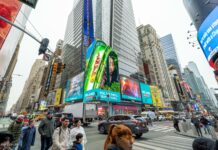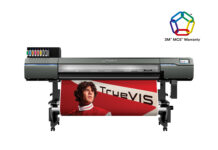Whether in a hotel, an office building or a school, each room must be identified by a sign readable even by those who are visually impaired. In fact, the Americans with Disabilities Act (ADA) mandates that all public buildings have permanent room identification signs, each of which must include large, clear lettering and Grade II Braille raised at least 0.031-inch (0.787 mm) from the background.
And since each room must be described by its function, as well as its location, there is little standardization, explains Bill Stecker, president of custom sign manufacturer Alchemy Dimensional Graphics (www.alchemy-dg.com) in Hillsborough, North Carolina. “In a building with 1,000 rooms, the only redundant room identification signs will be the restrooms,” he states.
Not only must these one-off dimensional signs meet the requirements of the ADA—which also specifies acceptable fonts and the level of contrast between the letters and the background—they must also be cost-effective to produce and yet still be durable and long-lasting.
“Typically, in the hotel industry, signage will be replaced every six to ten years,” says Stecker. “School signage, which is expected to last even longer, must also withstand more abuse.”
To address this demand, Alchemy developed compression molding processes using low-cost tooling and damage-resistant, high-performance thermoplastic sheet.
Forming a Raised Graphic Sign
Alchemy’s process begins with the machining of a mold with all text and graphics in reverse. Molds are used only once, so to keep tooling cost low, the company machines its molds out of a high-pressure laminate (phenolic/thermoset) using six CNC routers and one laser cutting system.
“If we are producing a letter ‘B,’ the mold cavity will be the letter in reverse, and it will be approximately 0.050-inch-deep,” explains Stecker, noting that his company uses a sheet of 0.125-inch-thick thermoplastic alloy from Boltaron Performance Products, LLC (www.boltaron.com) to either mold the entire three-dimensional sign or use as the substrate to which raised text and graphics are fused (depending on the coloring method selected).
To create raised text and graphics in contrasting colors, the company uses either of two methods. The first and most simple is to place a blank of Boltaron thermoplastic sheet against the mold and (using heat and high pressure) force the thermoplastic into all mold cavities. The resulting high spots of the molded sign are then “tipped” by screen printing with ink of a contrasting color, and then UV-cured.
The second process—and one that Alchemy actually patented—produces raised text and graphics having integral color. Instead of pressing a molten substrate into mold cavities, the cavities are first filled with a mixture of finely ground, pigmented acrylic or of metal powder mixed with finely ground clear acrylic. “We use a doctor blade to place the mixture into the mold cavity after which it is pre-cured,” adds Stecker. “We then clean off any excess powder from the planer area of the mold prior to compression molding.”
“Because the substrate is at forming temperature, it presses into the backside of the mold cavities and meets the powdered mixture,” continues Stecker. “The powder within the mixture melts and fuses to the substrate. This all occurs between 1000 and 4000 psi (6,900 and 27,600 kPa), which super densifies the mixture so that to the naked eye the metal appears to be continuous.”
(Note: The company uses five hydraulic presses with platen areas up to 36-by-48 inches that provide 85 to 750 tons of pressure necessary to form Alchemy’s detailed signage.)
The process produces raised text and graphics with integral color that is sharply delineated from the substrate surface and creates a refined visual effect, particularly with reflective metallics.
“The integral color of the materials maximizes the longevity of our signs, which will continue to look good even if scratched or subjected to wear and tear,” adds Stecker.
Factors to Consider
Readability is critical with this type of dimensional sign. According to the ADA Accessibility Guidelines, the greatest readability is usually achieved through the use of light-colored characters or symbols on a dark background, and research indicates that signs are more legible for persons with low vision when characters contrast with their background by at least 70 percent.
To many customers, however, the biggest concern regarding ADA compliancy is color consistency—especially where the color is associated with a logo or brand identification.
“We handle many long-term projects, such as a current one for 3,500 facilities over the next five years,” says Stecker. “That order specifies a custom chartreuse-off-green color, so it’s critical that color matching is precise batch-to-lot-to-year.
“Also crucial is minimizing costs, which we accomplish in part by ordering all of our sheet as cut-to-size blanks that drop right into our process. Because we are not required to purchase four-by-eight-foot sheets, we have virtually eliminated trim and waste.”
Alchemy’s compression molding process also allows laminating of two sheets to double the thickness when necessary. By laminating two sheets of differing color, it can bevel the edges to reveal the second color, creating a self-framing effect. Finished signs include integral text and graphics, as well as domed Braille.










